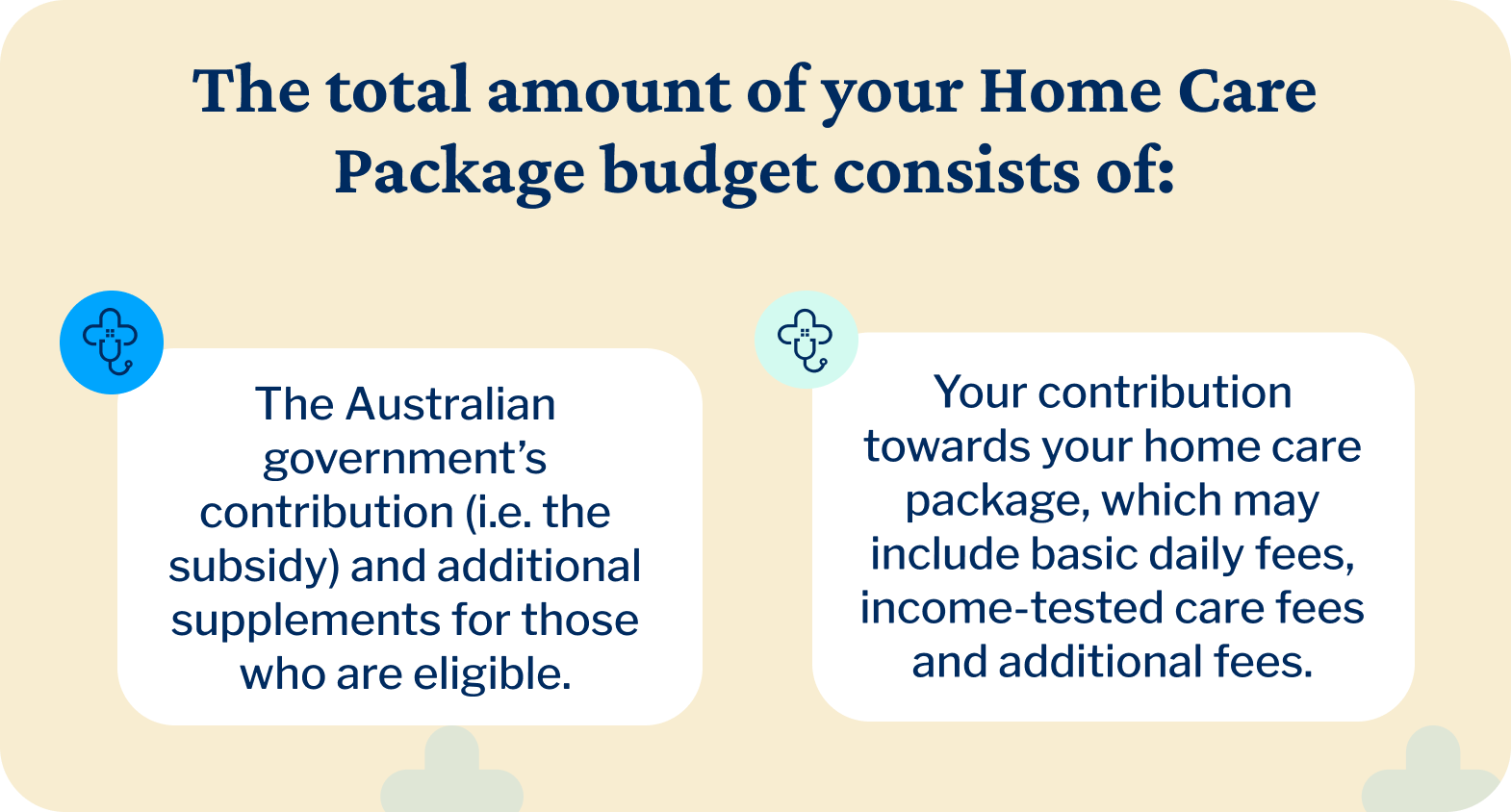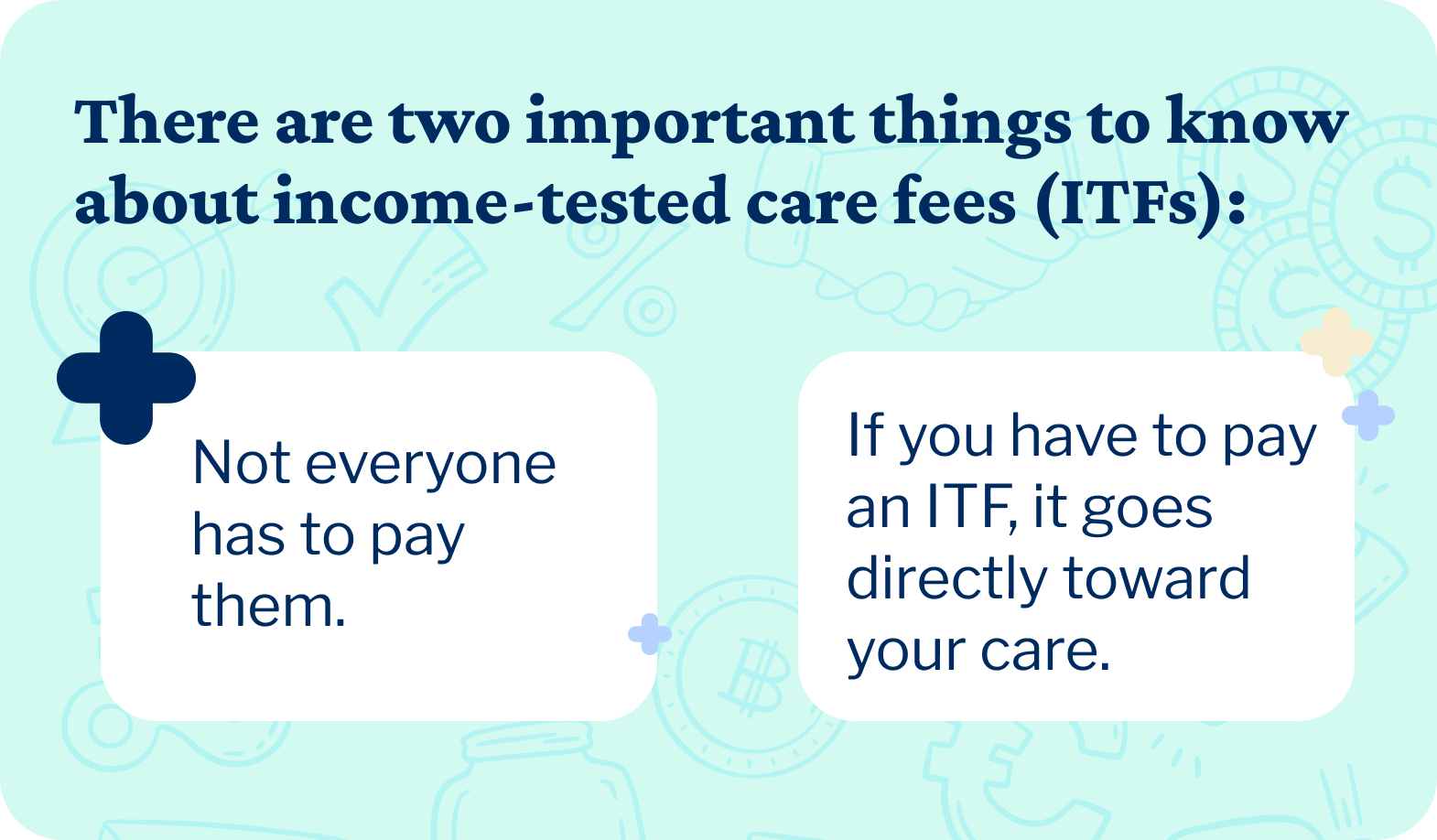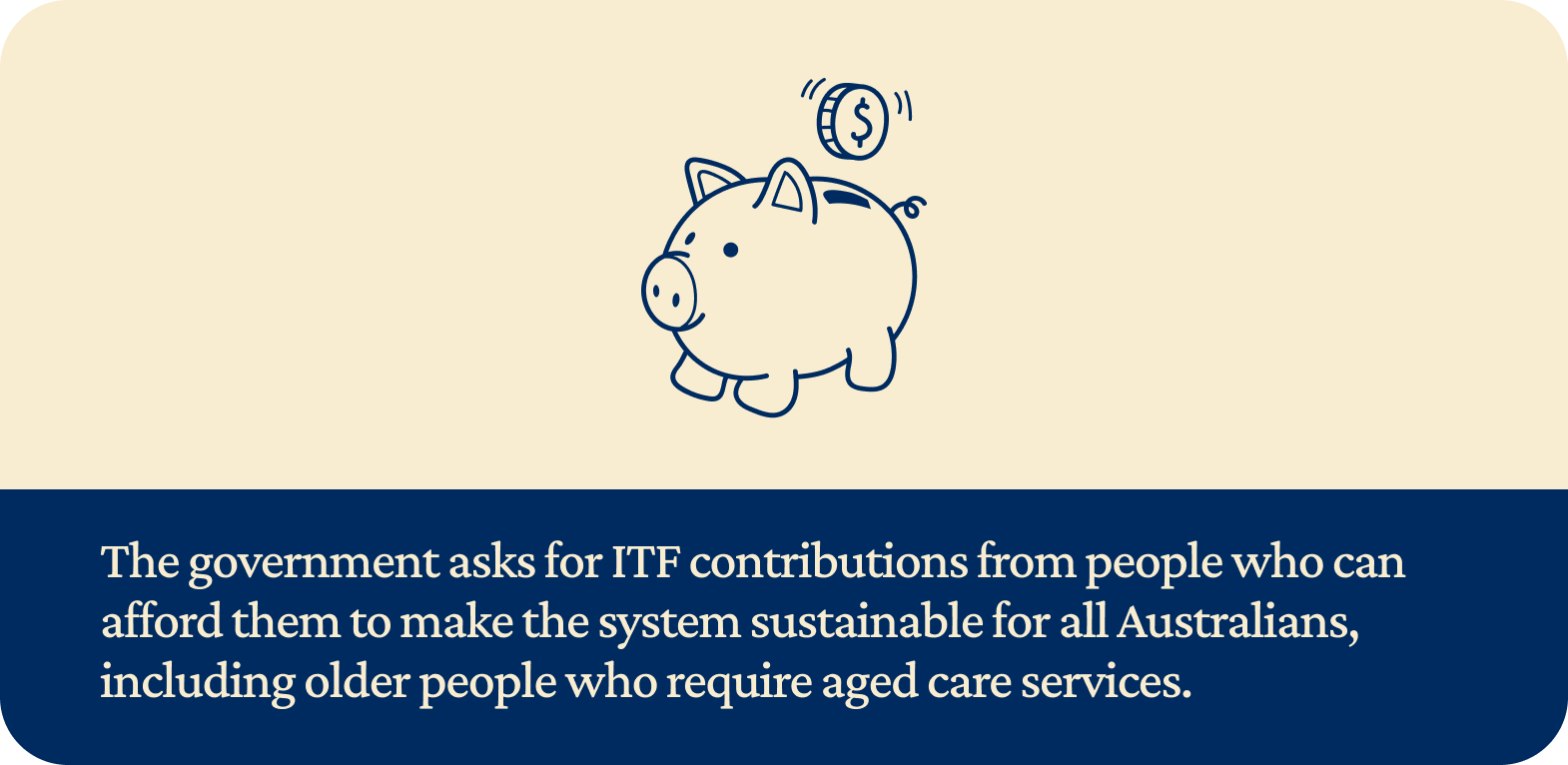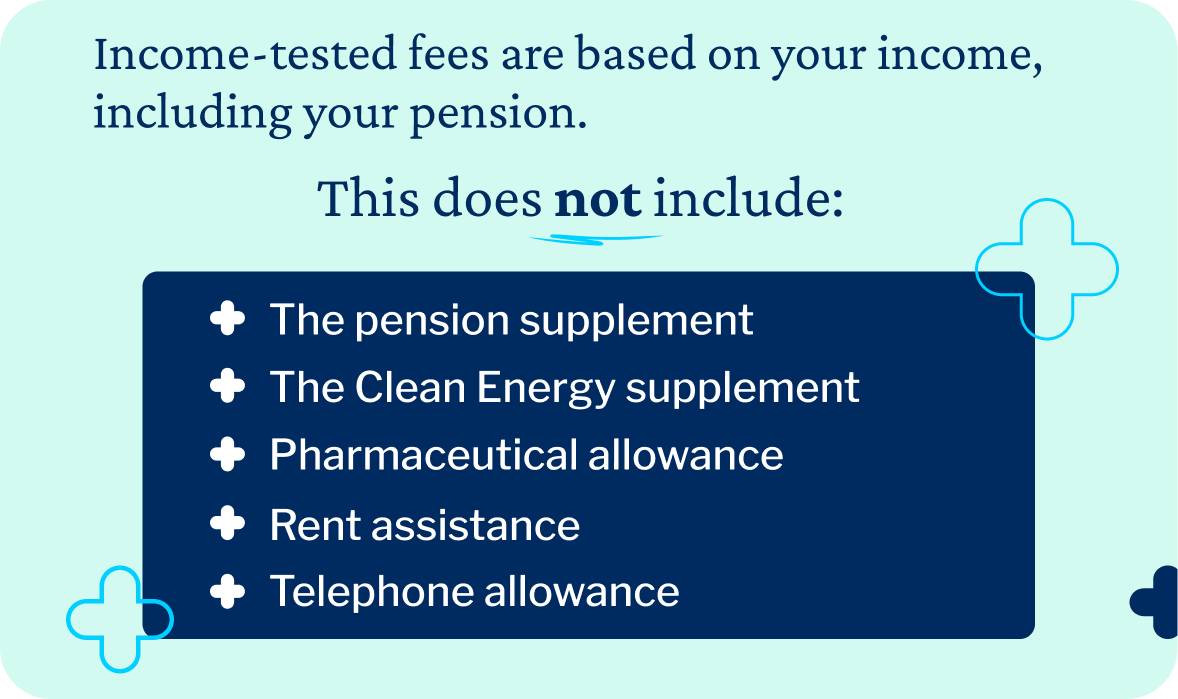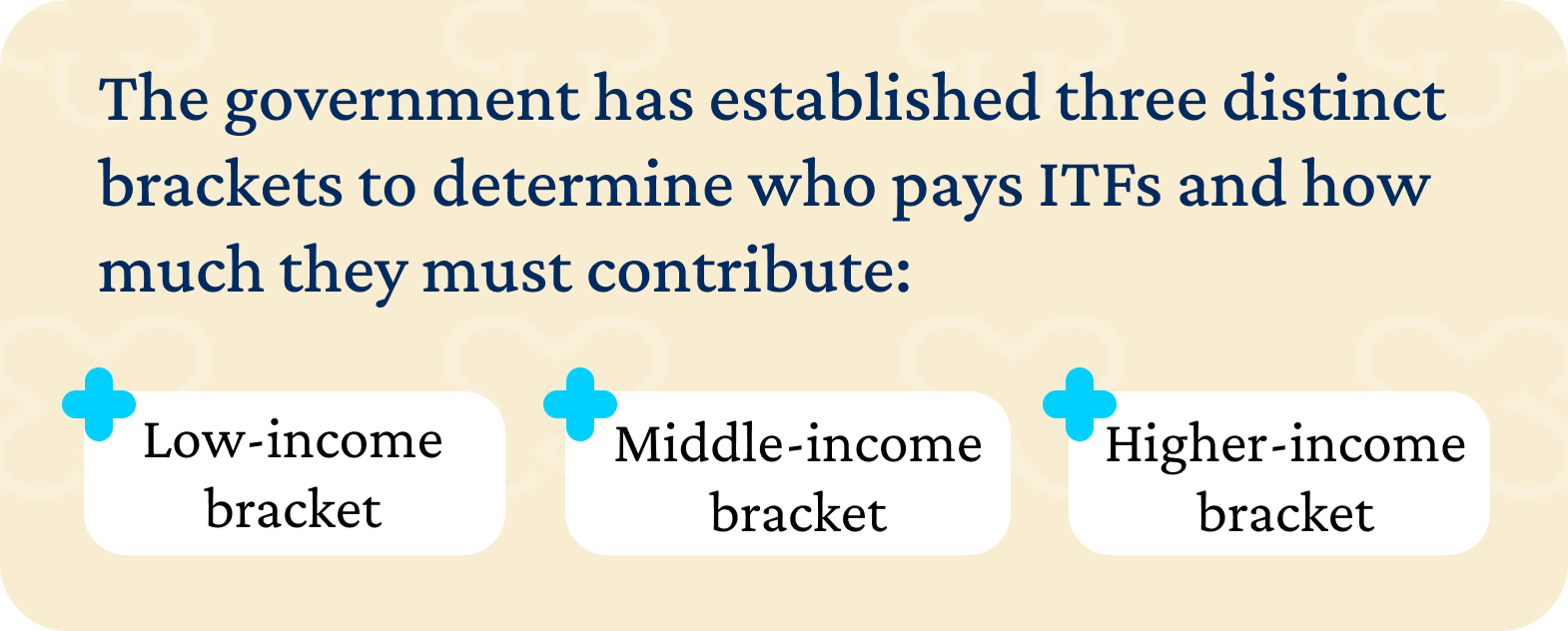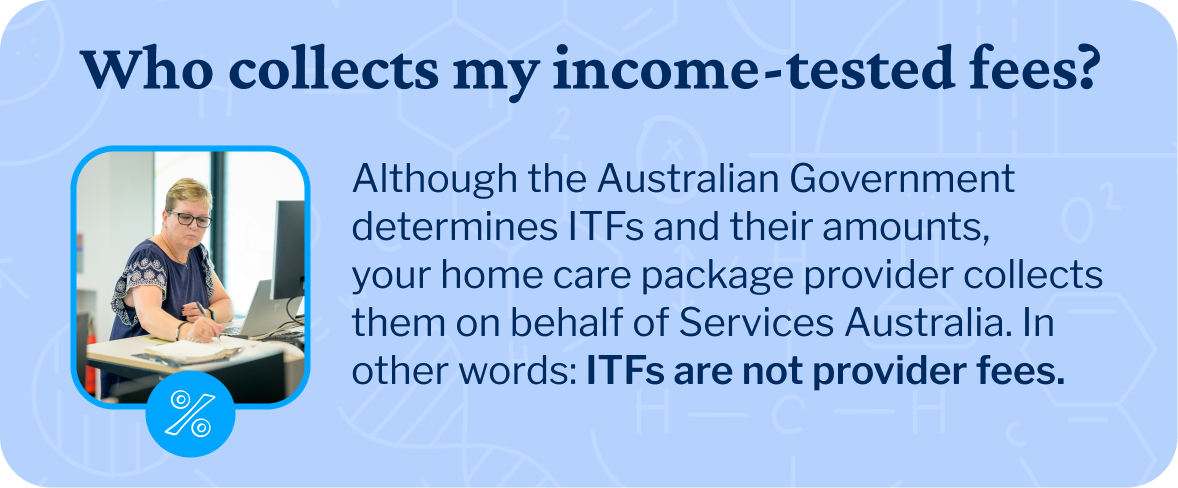Home Care Packages: Budgets, Costs & Fees
Income-tested care fees (ITFs) are often incorporated as part of the overall costs for Home Care Packages. Let’s briefly review the elements of Home Care Packages in Australia before we break down income-tested fees.
Home Care Packages are coordinated packages of care and services. They provide support so Australians can continue living independently in their homes while choosing the services and providers that best meet their care needs.
Home Care Package Budgets and Costs
There are four levels of Home Care Packages, and each level includes a specific amount of government-subsidised funding. Many Home Care Package recipients supplement that funding with their income-based contributions, effectively increasing the amount they have to spend on the providers, services and carers they need.
Ultimately, the total amount of your Home Care Package budget consists of:
- The Australian government’s contribution (i.e. the subsidy) and additional supplements for those who are eligible
- Your contribution towards your Home Care Package, which may include basic daily fees, income-tested care fees and additional fees
Home support and residential aged care in Australia are consumer-directed marketplaces, meaning customers can choose their providers. Conversely, care providers can charge different amounts for their services.
Your Home Care Package budget determines the total amount of funds available for you to use, and those funds cover the costs of your care and services based on your care plan. Visit the My Aged Care website and use the Find a Provider tool to compare provider costs and learn more about what agreeing to a Home Care Package entails.
Home Care Package Fees
The Australian government contributes a different amount of money for each level of Home Care Package, meaning the subsidy you receive for a level 3 package is different than the amount you receive for a level 4 Home Care Package. Those contributions are paid directly to the home care provider you choose to deliver your care. Government contributions change on July 1 every year, and up-to-date figures are available on My Aged Care.
Your contribution to your Home Care Package budget could come in the form of three different fees: a basic daily fee, an income-tested care fee and additional fees. Home care fees are paid for every day package funds are assigned to you—not just on days you receive support and services. Often, fees are paid on a fortnightly or monthly basis.
You might not have to pay any fees, though. Your contributions depend on two factors: your financial situation and the policies of the home care provider you choose. For instance:
- Basic daily fees are fees that everyone can be asked to pay. They are determined by the government and change in March and September every year in line with the age pension. Home care providers have the option to ask for this fee or not. The CareSide waives basic daily fees, but if you choose a provider that requires them, these fees are added to your Home Care Package subsidy to increase the amount of funding available for care.
- Additional fees (or additional service fees) depend on your care needs. If you opt for more care services than what is covered by your Home Care Package budget, additional service fees cover those costs as specified by an agreement between you and your provider.
The third type of fee, income-tested care fees (also known as means-tested care fees) are a bit more complex.
What is an income-tested care fee?
There are two important things to know about income-tested care fees (ITFs):
- Not everyone has to pay them. An income assessment determines who has to pay ITFs and how much their contribution must be.
- If you have to pay an ITF, it goes directly toward your care. In other words, your contribution to an ITF is added to your Home Care Package budget and used for the services, supports and care you agree to with your provider.
So why do income-tested care fees exist?
The government asks for ITF contributions from people who can afford them to make the system sustainable for all Australians, including older people who require aged care services. That’s why ITFs are different for everyone—they’re based on individual incomes and capped on an annual and lifetime basis.
Who has to pay income-tested fees in Australia?
Your income-tested fee is based on your income, including your pension. In this case, ‘income’ refers to the funds remaining after deducting income tax and the Medicare levy. It does not include:
- The pension supplement
- The Clean Energy Supplement
- Pharmaceutical allowance, rent assistance or telephone allowance
The fee estimator tool on My Aged Care can help you determine how much your income-tested fee will be—if you have to pay one at all. Those who must pay an ITF might also need to complete an income assessment to determine the exact amount.
How are income-tested care fees determined?
Full pensioners and Australians with an income up to $32,819.80 are not asked to pay an income-tested care fee. The government has established three distinct brackets to determine who pays ITFs and how much they must contribute:
Low-income bracket
Australians in this bracket do not have to pay an ITF if they are:
- Single with an annual income of $32,819.80 or less
- A member of a couple living apart due to illness earning $32,195.80 or less
- A member of a couple living together earning $25,420.20 or less
Middle-income bracket
Australians in this bracket may have to pay an ITF up to $18.30 if they are:
- Single with an annual income over $32,819.80
- A member of a couple living apart due to illness earning over $32,195.80
- A member of a couple living together earning over $25,420.20
Higher-income bracket
Australians in this bracket may have to pay an ITF between $18.30–$36.60 if they are:
- Single with an annual income over $63,351.60
- A member of a couple living apart due to illness earning over $62,727.60
- A member of a couple living together earning over $48,432.80
These amounts change with indexation every year in March and September.
Services Australia is responsible for calculating ITF contributions, though they’re also assessed by other organisations such as Centrelink and the Department of Veterans’ Affairs (DVA).
When you submit an income test form (SA456), three things happen:
- Assessors review your financial information to determine the fees you’re obligated to pay for home care services.
- The finalised amount is shared with you and your home care provider.
- The government deducts this amount from the total contribution it makes to your Home Care Package.
What if your financial situation changes during care?
Your income is reviewed twice a year in line with indexation, so if your financial circumstances change, your ITF changes accordingly. However, if your income changes significantly and you simply can’t wait for annual reviews, you can ask to have it reviewed at any time and submit another Income Tested Fee assessment form.
Visit the changes to aged care fees page on My Aged Care for more details.
Annual Cap and Lifetime Cap amounts for income-tested fees
Annual and lifetime caps on income-tested care fees make them more affordable—and easier to plan for. Plus, if you reach these caps while utilising home care services, they carry over to aged care homes if that change becomes necessary in the future.
Once you reach a cap, you cannot be asked to pay any more income-tested fees. And just like the fee amounts, cap amounts are indexed in March and September every year. (Important note: the applicable cap amounts for your situation are the ones that are current when you reach them, not the ones that were current when you began care.)
As of March 2024, the lifetime cap amount is $79,942.44, meaning care recipients who reach that amount no longer have to pay income-tested fees.
There are two types of annual caps, and the one that applies to you depends on your annual earnings:
- If you are a part pensioner (or self-funded retiree) or if your annual income falls between $32,819.80–$63,351.60, your income-tested fee is capped at $18.30 per day ($6,661.80 per year).
- If your annual income eclipses $63,351.60, your income-tested fee is capped at $36.60 per day ($13,323.68 per year).
Keep in mind: if you have a full-age pension or an income up to $32,819.80, you do not have to pay an ITF.
Income-Tested Care Fees: Additional Resources
When you’re exploring the marketplace for home care services, determining how much you have to pay in fees is an important step in deciding which services and Home Care Package providers are best for you. Basic daily fees, income-tested fees and additional fees all hinge on your Home Care Package level, the results of your income assessment, and your agreement and care plan with a provider.
Below you’ll find a few more FAQs regarding income- and means-tested fees, but if you still need help, contact The CareSide today by calling 1300 85 40 80 or by completing our website form with your information.
We are an approved provider managing Home Care Packages and home support services, and we understand how complex care can be. Our team can help you determine the best course of action for your home care needs — we’ll answer your questions, explain complicated government language, break down home care pricing and fees, and assist you with whatever else you might need!
Income-Tested Care Fee FAQs
How do I estimate home care fees?
The fee estimator tool on My Aged Care can help you figure out how much you might pay.
How can I find out the amount of fees I’ll need to pay?
The exact amount is determined once you’ve completed an income assessment and signed a home care agreement.
When do I start paying the income-tested fee?
Home Care Package applicants are required to complete the means-tested assessment, which can be done up to 120 days before they start their HCP. Once the assessment is submitted, it generally takes Services Australia 6-12 weeks to complete their determination.
Do all Home Care Package recipients need to fill out an income assessment?
Not necessarily. Services Australia or the Department of Veterans’ Affairs might already have your financial details if you are receiving an Australian Government means-tested income support payment. Use the income and means assessment tool on My Aged Care to learn more about your situation.
What happens after I submit an income assessment?
Services Australia will send you a fee advice letter covering whether or not you have to pay an income-tested fee and how much it will be. The letter is valid for 120 days unless your situation changes significantly during that time.
What if I disagree with the results of my income assessment?
You can ask Services Australia (or in some cases, the Department of Veterans’ Affairs) to review their findings and they will follow up with you.
What if I can’t afford my home care or aged care fees?
Sometimes, people can’t afford their in-home care costs and fees for reasons beyond their control. In those cases, financial hardship assistance is available for those with eligibility. Visit My Aged Care to learn about financial hardship assistance.
Can I get financial advice before making a home care decision?
Yes, Services Australia’s Financial Information Service (FIS) is available to all Australians for free. FIS officers help people understand aged care costs, how different payment methods can impact your pension and more. Contact FIS at 132 300 and say ‘Financial Information Service’ as the reason you’re calling.
Are income-tested care fees called other names?
Often, ‘income-tested fee’ is used when referring to home care, while ‘means-tested fees’ and ‘income and assets fee’ are used when referring to aged care in general.
Who collects my income-tested fees?
Although the Australian Government determines ITFs and their amounts, your Home Care Package provider collects them on behalf of Services Australia. In other words: ITFs are not provider fees.


